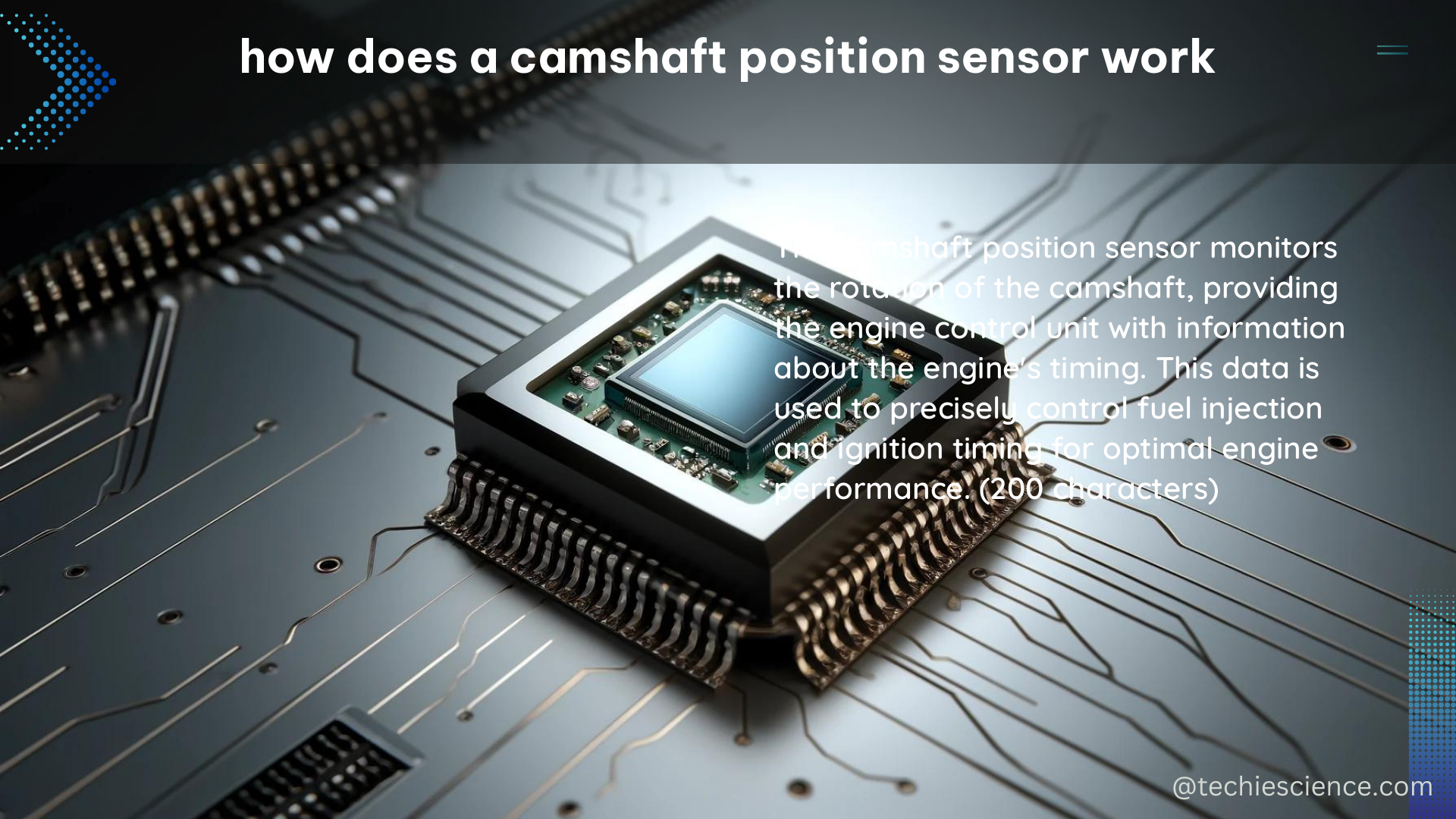A camshaft position sensor is a crucial component in modern vehicles, responsible for monitoring the position and speed of the camshaft and transmitting this data to the engine control module (ECM). The ECM then uses this information to precisely control the amount of fuel entering the combustion chamber and the ignition timing, resulting in improved engine power, fuel efficiency, and reduced emissions.
Understanding the Camshaft Position Sensor
The camshaft position sensor operates on the Hall effect principle, which involves a ring gear attached to the camshaft. As the camshaft rotates, the ring gear’s movement changes the Hall voltage of the Hall IC within the sensor head. This voltage change is then transmitted to the ECM, which can determine the camshaft’s position and speed.
Sensor Structure and Components
A typical camshaft position sensor consists of the following key components:
- Sensor Housing: The sensor housing is the outer casing that protects the internal components and mounts the sensor to the engine.
- Hall IC: The Hall IC is the heart of the sensor, responsible for detecting the changes in the magnetic field as the camshaft’s ring gear rotates.
- Magnet: The magnet generates a constant magnetic field, which is then influenced by the rotating ring gear.
- Encoder Wheel: The encoder wheel, also known as the trigger wheel or reluctor ring, is a toothed ring attached to the camshaft. As the camshaft rotates, the encoder wheel’s teeth pass by the sensor, causing changes in the magnetic field.
- Connector: The connector provides the electrical interface between the sensor and the vehicle’s wiring harness, allowing the sensor to transmit its data to the ECM.
Sensor Operation
The camshaft position sensor works as follows:
- The encoder wheel, attached to the rotating camshaft, passes by the sensor’s magnetic field.
- As each tooth on the encoder wheel passes the sensor, it causes a change in the magnetic field, which is detected by the Hall IC.
- The Hall IC converts these changes in the magnetic field into electrical signals, which are then transmitted to the ECM.
- The ECM uses the camshaft position data to precisely control the fuel injection and ignition timing, ensuring optimal engine performance.
Symptoms of a Faulty Camshaft Position Sensor

A malfunctioning camshaft position sensor can cause a variety of symptoms, including:
- Check Engine Light: A faulty camshaft position sensor will typically trigger a diagnostic trouble code (DTC), causing the Check Engine light to illuminate on the dashboard.
- Rough Idling or Stalling: Incorrect camshaft position data can lead to improper fuel delivery and ignition timing, resulting in rough idling or even engine stalling.
- Decreased Fuel Efficiency: A faulty camshaft position sensor can cause the engine to run inefficiently, leading to decreased fuel economy.
- Transmission Shifting Problems: The ECM uses camshaft position data to coordinate the transmission’s shifting, so a faulty sensor can cause erratic or delayed gear changes.
- Difficulty Starting: If the ECM cannot accurately determine the camshaft’s position, it may have trouble starting the engine, especially when the engine is cold.
Causes of Camshaft Position Sensor Failure
There are several common reasons why a camshaft position sensor may fail, including:
- Electrical Issues: Problems with the sensor’s wiring, such as a faulty connection, short circuit, or voltage issues, can lead to sensor failure.
- Mechanical Damage: Physical damage to the sensor, such as from engine vibrations or a collision, can cause the sensor to malfunction.
- Sensor Wear: Over time, the sensor’s internal components can wear down, leading to a loss of accuracy or complete failure.
- Encoder Wheel Damage: If the encoder wheel attached to the camshaft becomes damaged or worn, it can cause inconsistent signals to be sent to the sensor.
- Sensor Misalignment: Improper installation or engine modifications can result in the sensor being misaligned with the encoder wheel, leading to inaccurate readings.
Camshaft Position Sensor Maintenance and Replacement
To ensure the longevity and proper functioning of the camshaft position sensor, it’s essential to follow these maintenance and replacement guidelines:
- Regular Inspection: Periodically inspect the sensor and its wiring for any signs of damage or wear, such as cracks, loose connections, or corrosion.
- Proper Replacement: When the sensor needs to be replaced, ensure that the new sensor is compatible with your vehicle’s make, model, and year. Follow the manufacturer’s instructions for proper installation and alignment.
- Diagnostic Testing: If you suspect a problem with the camshaft position sensor, use a diagnostic tool to check for any diagnostic trouble codes and perform further testing to isolate the issue.
- Preventive Maintenance: Regular engine maintenance, such as oil changes and tune-ups, can help extend the lifespan of the camshaft position sensor and other engine components.
By understanding the structure, operation, and common issues associated with the camshaft position sensor, you can better maintain your vehicle’s engine performance, fuel efficiency, and overall longevity.
References:
- Camshaft Position Sensor Symptoms
- Camshaft Position Sensor: Technical Information
- Camshaft Position Sensor (CMP): Understanding the Structure, Symptoms, Maintenance, and Costs
- How Does the Camshaft Position Sensor Work?
- How the Camshaft Position Sensor Work

The lambdageeks.com Core SME Team is a group of experienced subject matter experts from diverse scientific and technical fields including Physics, Chemistry, Technology,Electronics & Electrical Engineering, Automotive, Mechanical Engineering. Our team collaborates to create high-quality, well-researched articles on a wide range of science and technology topics for the lambdageeks.com website.
All Our Senior SME are having more than 7 Years of experience in the respective fields . They are either Working Industry Professionals or assocaited With different Universities. Refer Our Authors Page to get to know About our Core SMEs.